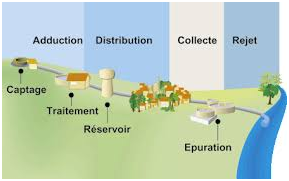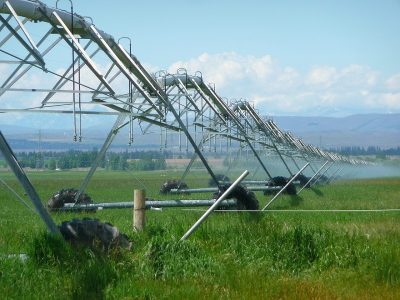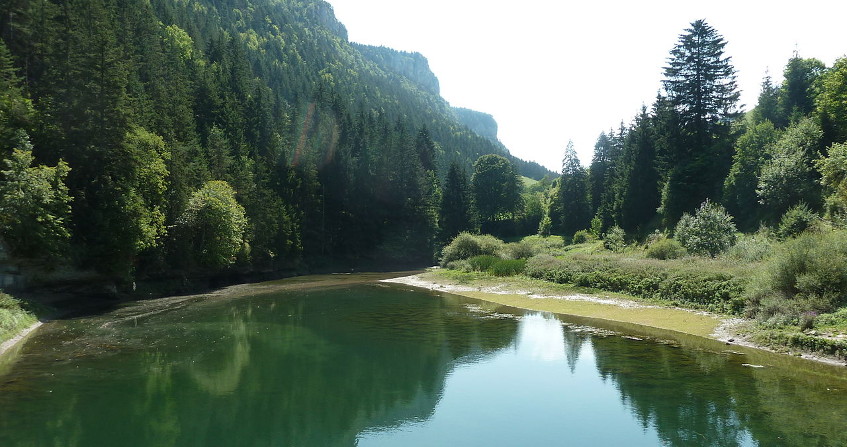我们是否面临水资源短缺的风险?

地球上的水基本上都是咸的,然而正是海洋表层的海水通过蒸发、凝结和降水,推动了地球的水循环,其热动力来源便是太阳辐射。这种水循环为陆地提供水,其中包括在河流和地下流动的“蓝水”和雨后储存在土壤中随后被植被吸收和蒸腾的“绿水”。这些水流几乎完全被陆地和海岸自然生态系统所利用,因为生命已经四处发展,达到了可利用资源的承载极限。在全球范围内,人类分配到的水资源依然是适中的:7%的蓝水和9%的绿水,但是人类的空间分布与水资源的空间分布并不一致:21.5%的人口生活在只有人类2%蓝水资源的大草原和干旱地区。此外,由于人口增长和饮食习惯的变化,对水的需求也在增加,而水资源还正受到气候变化的影响。那么我们该如何解决2050年乃至2100年由水的供需不平衡所带来的挑战,同时尽可能地避免水短缺及由此造成的饥荒、血腥冲突和大量移民?
1. 我们有多少水?

[来源:DLR, CC-BY 3.0 (http://creativecommons.org/licenses/by/3.0/de/deed.en)]通过维基共享
地球最初形成的时候是无水的或少水的,水都聚集在离太阳更远的类木行星和彗星带(奥尔特云和柯伊伯带),地球上大部分水是在地球形成后的几亿年内才出现的。按比例来说,地球是陆地行星(水星、金星、地球和火星)中水含量最高的。地球水的彗星起源学说最初受到支持,现在却受到严重的质疑,特别是在欧洲太空总署的罗塞塔任务之后。该任务在2014年11月12日发射了菲莱探测器(见图1)登陆67P / 丘留莫夫-格拉西缅科彗星并特别测量其冰中的氘含量:这种氢的同位素(即氘)的含量是地球上的两倍;因此,这种类型的彗星(无论如何)不可能是地球上水的起源,因此人们的目光转向了来自岩质或者铁质小行星的撞击,这些小行星中也含有少量的水。
地球上97%的水都是咸水,它们在太阳辐射的作用下蒸发,经过凝结和降水,推动了地球水循环。通过这种方式,每年有113,000 立方千米的水(日内瓦湖容量的1270倍)被带到陆地,它们被分为降水后流入河流和下渗到含水层的蓝水(32%)、存储在土壤而后被根系吸收并由植被蒸腾的绿水(65%)以及3%的冰川融水(Hoekstra and Mekonnen, 2012)。 我们的水资源本质上来源于地球水循环的这些输入。
全球变暖(请阅读: 气候的机制 )将加速这一循环,平均来看,增加地球上的降水同时将气候带移向两极,从而导致地中海纬度地区的干旱化:这些地区的可耕种面积将会减少1.1亿公顷,但同时在更北纬度地区(加拿大、西伯利亚)的可耕种面积将会因气候变暖而增加1.6亿公顷。预计极端天气(洪水、干旱)的频率也会增加。例如在法国,预计到本世纪末降水将会减少10%至20%,特别是在夏季减少更多。
2. 我们使用的水
目前,人类消耗了蓝水的7%,但开采的水量更高(13%),消耗的部分(主要是灌溉用水)通过蒸发并返回到大气中,而未使用的部分则以液态水的形式下渗和返回至地下水和河流中。我们使用9%的绿水用于农业,其余绿水则进入自然生态系统(森林、草原、湿地)。我们还以大约每年100立方千米的速度提取少量的化石水,这些水主要储藏在一些国家(印度、美国、中国、巴基斯坦、伊朗、墨西哥)的地下蓄水层中(Döll et al., 2014)。但这种情况是不可持续的,这些含水层的储量将在几十年内耗尽,这就需要我们从喜马拉雅大河流(长江、恒河等)或其他水资源丰富的地方通过运河调水。由于阿尔卑斯山、喜马拉雅山、落基山脉等地的一些河流过热高山冰川融加剧,尤其是安第斯山脉,由融水汇聚的河流将在不到30年的时间就会干涸,而这些融水是拉巴斯和秘鲁太平洋沿岸城市的生活用水主要来源。

Captage:开采水,Adduction:供应,Traitement:处理,Reservoir:水塔或水库,Distribution:供水,Collecte:污水收集,Epuration:污水净化,Rejet:排放
人均生活用水量(其定义见图2)的范围为每天20至500升,平均值为每天300升,或人均每年110立方米。在法国,人均生活用水量的估计值是150升/天。到2050年,世界人口将增加到95亿(Gerland et al.,2014),2100年将增加到110亿,其中令人担忧的人口增长主要在非洲地区(2000年10亿,2050年25亿,2100年42亿……)。以人均250升/天计算,2050年地球所需的生活用水总量将为870 km3 /年,占降水量的0.8%、或蓝水的2.4%。因此,生活用水不存在量的问题,而是运输和水质的问题,因此也是供应和处理基础设施的问题。如果能及时建造这些基础设施,地球上的生活用水永远不会短缺。位于沙漠中心的纳米比亚首都温得和克市(35万名居民),30年来一直靠大坝和一条800公里长的管道供水,同时对处理后的污水进行再生回用,这些水被重新注入当地的地下含水层!
工业用水方面,人均的使用量为每年1300m3左右。但这些水实际只消耗了10%; 其余的90%被排放到环境中,这些水如果不加以处理的话,环境中的水可能会被加热(冷却水)或被污染。

水资源主要消耗在农业用水(见图 3)上(Griffon,2006;Agrimonde,2010;Leridon 等,2011;Marsily(等),2006、2015a、2015b)。 如今我们每年需要上万立方千米的水来养活地球上的72 亿人:6,500 立方千米的绿水 15 亿公顷的雨养农业用地和 32 亿公顷的牧场上的。 此外,还需从河流和地下水中抽提 3,500立方千米的蓝水(实际利用其中的50%),用于浇灌2.8 亿公顷的灌溉用地。因此,养活人类最终需要 8,000 立方千米/年,即每人每年 1,150 升3(比生活用水多十倍)。 然而遗憾的是,在撒哈拉以南非洲和东南亚有 10 亿人仍然营养不良,他们生活在水量充沛的地区,而不是干旱地区; 这种情况是欠发达导致的(农业生产效率低下和产量不足、投入使用率极低、缺乏发展:水坝、灌溉区……),参见图 4。由于缺乏可耕种的土地或水,许多国家也无法生产足够他们需要的食物:他们的人口已经超出了该国当地资源能够养活人口的极限,同时饮食习惯也发生了变化;他们必须从粮食产量富余的国家(北美和南美、澳大利亚、泰国、法国)进口食物。现在,地球上生产的食物中有 30% 以上是从一个国家运输到另一个国家的,主要是通过航运的手段运输,它们被称为虚拟水,因为缺水国家不是通过进口水而是通过进口食物来解决粮食不足问题,而生产这些粮食需要水。

Little or no water scarcity:很少或者没有水短缺,Approaching physical water scarcity:接近物理上缺水,Physical water scarcity:物理上缺水,Economic water scarcity:经济发展问题导致的缺水
粮食进口国为支付这些粮食进口费用,需要出口能源或矿物原材料,从事工业或第三产业活动,发展旅游业,或者获得海外移民的汇款。一些国家出口高价值的农产品(咖啡、可可、棉花),然后进口食品。但因此进口国就会产生依赖性,一旦出现全球性粮食短缺,就会面临来自政治压力和价格压力的风险。由于缺乏可耕种的土地,目前对所有干旱地区(北非、中东)的国家和未来对整个亚洲而言都不可能实现粮食自主。我们看到像中国这样的国家,正在发展中国家购买重要的农田(特别是在非洲和南美),种植自己的作物,然后进口他们需要的粮食到他们的国家。因此约旦70%的粮食需要进口,而吉布提则超过90%。图4显示了根据蓝水资源或需求划分的世界区域。
3. 未来的水资源
到2050年,按目前的饮食习惯,若要满足每个人的饮食需求,每年需要11,000 立方千米的水。这是可以实现的,前提是粮食短缺国家能够负担得起从粮食出口国购买他们的粮食,并且粮食出口国同意生产超出他们自己需要的粮食。但如果肉类消费增大,则将需要13,000 立方千米/年的水量。肉类消费对水的需求有很大的影响:每生产1公斤由谷物饲养的牛肉需要13,000升水,这是生产1公斤小麦的13倍!
这11,000到13,000 立方千米/年的用水量将用于雨养农业和灌溉农业:我们将不得不增加亩产量和各地的耕地面积,但是谁又能保证会有(只能通过土地开垦才能发展的)更大的雨养农业规模和(只有通过大坝建设才能提升的)更强的灌溉能力呢?修建水坝或开荒必然会造成有害的环境后果,但如果世界人口继续增长,我们难道不应该尝试以危害最小的方式养活他们吗?海水淡化的成本约为0.7欧元/升,耗电量为2 到4 千瓦时/ m3:这对于灌溉用水来说成本和电耗太高,大约是通常花费的10倍,但对于生活用水来说却是可以接受的。

遗憾的是,我们似乎又要去了解整个世界大家庭了。在1998年,东南亚(中国和印度尼西亚)发生了严重干旱,致使他们从世界市场上大量购买谷物,世界粮食库存急剧减少,如果当时干旱持续下去,库存将会不足(Rojas et al. 2014; Lizumi et al. 2014)。然而,世界粮食库存已经从20年前的能够满足10个月的全球消费量降低至今天的仅能维持2个月全球消费量……这些年发生在季风地区的严重干旱与非常强烈的厄尔尼诺事件有关。根据南美洲教区记录汇编的统计数据(Orltieb, 2000),厄尔尼诺事件平均每世纪发生两次,例如19世纪观测到的厄尔尼诺现象发生在1876-1878年和1896-1900年,每次厄尔尼诺事件造成约3000万人死亡(Sen和Drèze, 1999年);在20世纪,它们分别发生在1940年和1998年。气候变化对厄尔尼诺现象在频率和强度上的影响目前受到广泛讨论。
我们会对未来农业生产需求感到担忧。我们可以首先对比一下粮食浪费的情况,因为今天有大约30%的食物或在富裕国家被丢弃,或在贫穷国家因歉收或保存不当而损失;我们还可以对比饮食,因为根据国家的不同,土地所有者每年所需的水量从600 m3到2500 m3不等,动物产品(荤类食物)的消费是导致所需水量变化的主要因素:富裕国家消费的动物产品大约是营养需求的两倍,新兴国家总体上处于适当的水平,而贫穷国家平均来说则低于需求的三分之一。但要满足缺水国家的粮食需求,只有三种选择:通过建设巨大的人工渠道输送水,就像中国已经决定去做的(或者印度应该决定去做的)那样;以食物的形式转移虚拟水;或最终接受人口从缺水国家向富裕国家的迁移,这些人被血腥的冲突和饥饿骚乱赶出家园,最近的历史已经给出了残酷的例子(参见与本文相关的焦点)。我们今天面临的移民问题只是漫长历史的开始,这一问题将随着气候变化、人口增长和动物产品消费的增加而加剧……
参考资料及说明
ARIMOND (2010) Scenarios and challenges for feeding the world in 2050. Coordinated by S. PAILLARD, S. TREYER & B. DORIN. Editions Quae, Versailles, 295 p.
DIAMOND, J. (2006) Collapse. How societies decide on their disappearance or survival. Gallimard, Paris, 648 p. (Translated from the English, “Collapse”, Viking Penguin, 2005).
DÖLL, P., MÜLLER SCHMIED, H., SCHUH, C., PORTMAN, F.T., EICKER, A. (2014) Global-scale assessment of groundwater depletion and related groundwater abstractions: combining hydrological modeling with information from well observations and GRACE satellites. Water Resour Res. doi:10.1002/2014WR015595
GERLAND P., RAFTERY A., SEVCIKOVA H., LI N., GU D., SPOORENBERG T., ALKEMA L., FOSDICK B., CHUNN J., LALIC N., BAY G., BUETTNER T., HEILIG G. & WILMOTH J. (2014) World population stabilization unlikely this century. Science, 346 : 234-237 ; doi: 10.1126/science.1257469.
GLEICK, P.H. (2014) Water, Drought, Climate Change, and Conflict in Syria. Wea. Climate Soc., 6, 331-340; doi: http://dx.doi.org/10.1175/WCAS-D-13-00059.1.
GRIFFON M. (2006) Feeding the planet. Odile Jacob, Paris: 456 p.
HOEKSTRA, A., M. MEKONNEN (2012) The water footprint of humanity. Proceedings of the National Academy of Sciences of the USA. www.pnas.org/cgi/doi/10.1073/pnas.1109936109
IWMI (INTERNATIONAL WATER MANAGEMENT INSTITUTE) (2007) Water for Food, Water for Life: the Comprehensive Assessment of Water Management in Agriculture. D. Molton (ed.), Earthscan, London, UK, 645 p.
LERIDON, H., MARSILY G. de, coord. (2011) Demography, climate and global food supply. EDP Sciences – Report of the Académie des Sciences, Paris, 313 p. (and www.academie-sciences.fr)
LIZUMI, T., LUO, J., CHALLINOR, A., SAKURAI, G., YOKOZAWA, M., SAKUMA, H., BROWN, M., YAMAGATA, T. (2014) Impacts of El Niño southern oscillation on the global yields of major crops. Nat Commun 5:3712. doi:10.1038/ncomms4712
MARSILY, G. de (2006) Les Eaux Continentales. EDP Sciences, Report of the Académie des Sciences, Paris, 328 p. (and www.academie-sciences.fr)
MARSILY, G. de (2015a) Water, a coveted renewable resource and unequally distributed. Ann. Northern Geol. Soc. T. 22 (2nd series), December 2015.
MARSILY, G. de, ABARCA DEL RIO, R. (2015b) Water and Food in the 21st Century. Surveys in Geophysics, v.36, n°4, July 2015, DOI 10.1007/s10712-015-9335.
ORTLIEB, L. (2000) The documented historical period of El Niño events in Peru: an update of the Quinn record (16th to 19th centuries). In: DIAZ H.F. & MARKGRAF V. eds, El Niño and the southernoscillation. Multiscale variability and local and regional impacts. Cambridge University Press: 496 p.
ROJAS, O., LI, Y., CUMANI, R. (2014) Understanding the drought impact of El Niño on the global agricultural areas: an assessment using FAO’s Agricultural Stress Index (ASI), FAO, Climate, energy and tenure division (nRc) publications. ISBN: 978-92-5-108671-1, ISSN 2071-0992
SEN, A., DRÈZE, J. (1999) Omnibus. Oxford University Press, New Delhi (India): 945 p.
WILS, W., CARAEL, M., TONDEUR, G. (1986) Le kivu Montagneux : overpopulation, undernutrition, soil erosion. Mem. Acad. Royale Sc.Outremer Belgique, tome 21,fasc.n° 3.
WELZER, H. (2012) Climate Wars: what people will be killed for in the 21st century. Wiley. ISBN: 978-0-7456-5145-3
环境百科全书由环境和能源百科全书协会出版 (www.a3e.fr),该协会与格勒诺布尔阿尔卑斯大学和格勒诺布尔INP有合同关系,并由法国科学院赞助。
引用这篇文章: DE MARSILY† Ghislain (2024年3月9日), 我们是否面临水资源短缺的风险?, 环境百科全书,咨询于 2025年4月1日 [在线ISSN 2555-0950]网址: https://www.encyclopedie-environnement.org/zh/eau-zh/are-we-at-risk-of-water-shortage/.
环境百科全书中的文章是根据知识共享BY-NC-SA许可条款提供的,该许可授权复制的条件是:引用来源,不作商业使用,共享相同的初始条件,并且在每次重复使用或分发时复制知识共享BY-NC-SA许可声明。








